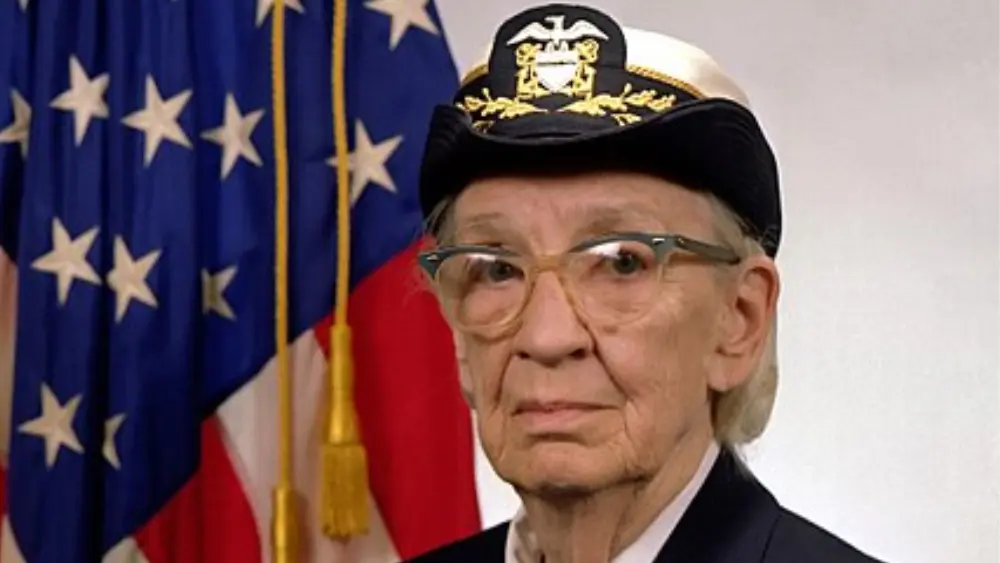Grace Hopper, born on December 9, 1906, in New York City, was a trailblazing American computer scientist and U.S. Navy rear admiral. Renowned for her groundbreaking contributions to computer programming and technology, Hopper’s legacy extends beyond the military to the very foundations of modern computing.
Early Life and Academic Prowess
Grace Hopper’s early life was characterized by a profound intellectual curiosity and a passion for mathematics. Born in 1906, she demonstrated an early aptitude for the subject and pursued her education with unwavering determination. In 1934, Hopper earned her Ph.D. in mathematics from Yale University, a remarkable achievement that not only showcased her academic prowess but also marked her as one of the first women to receive a doctorate in the field. This early academic accomplishment set the stage for Hopper’s subsequent groundbreaking contributions to the emerging field of computer science.
Hopper’s academic journey laid the foundation for her illustrious career, which would see her become a trailblazing figure in the world of computing. At a time when women faced significant barriers in academic and professional spheres, Hopper’s academic achievements stood as a testament to her resilience and intellect, foreshadowing the transformative impact she would later have on the development of computer technology.
Grace Hopper: Early Contributions to Mathematics
Before embarking on her distinguished military career, Grace Hopper had already made a lasting impact on the field of mathematics through her groundbreaking contributions. Following the completion of her Ph.D. in mathematics from Yale University in 1934, Hopper began teaching at Vassar College, where she continued to make noteworthy contributions to the field. Her work included research on new mathematical techniques and the development of groundbreaking concepts, laying the groundwork for her future impact on the emerging field of computer science.
Hopper’s early contributions to mathematics not only showcased her intellectual prowess but also revealed her innovative mindset. She approached mathematical challenges with a unique perspective, foreshadowing the lateral thinking and creative problem-solving that would later distinguish her contributions to the development of early computers. Hopper’s academic accomplishments in mathematics represented the initial chapter of a remarkable career that would eventually redefine the landscape of computing and establish her as one of the most influential figures in the history of technology.
World War II Service: The Navy and the Harvard Mark I
Grace Hopper’s significant contributions during World War II positioned her as a pioneering figure in the nascent field of computing. Commissioned as a lieutenant in the Women’s Reserve (WAVES) of the U.S. Navy, Hopper played a vital role in advancing military technology. Her involvement in the development and operation of the Harvard Mark I computer marked a pivotal moment in her career. The Harvard Mark I was a colossal electromechanical computer designed for complex calculations, including artillery trajectory predictions and other military computations. Hopper’s work on the Harvard Mark I not only demonstrated her technical acumen but also revealed her commitment to harnessing the power of computation for practical military applications.
Hopper’s service during World War II laid the foundation for her enduring legacy in the world of computing. Her experiences with the Harvard Mark I deepened her understanding of computers’ potential and ignited her passion for programming languages. Little did she know that this wartime contribution was just the beginning of a groundbreaking journey that would see her become a trailblazer in the development of programming languages and a driving force behind the evolution of modern computing.
Grace Hopper: Pioneering Computer Programming
Grace Hopper’s pioneering contributions to computer programming during her tenure at Harvard were groundbreaking and set the stage for her illustrious career in the field of computing. She emerged as one of the first programmers of the Harvard Mark I, a monumental electromechanical computer used for various military calculations during World War II. Hopper’s work on the Mark I showcased her exceptional programming skills and marked the beginning of her trailblazing journey into the world of computing.
Her legacy continued to evolve as she transitioned to work on the UNIVAC I, the first commercially produced computer in the United States. Hopper played a pivotal role in the development of this innovative machine, contributing to its programming and solidifying her reputation as a leading figure in the early days of computer science. The UNIVAC I’s successful operation and Hopper
COBOL: A Language for the Masses
Grace Hopper’s most enduring contribution to the world of computing is undeniably the development of COBOL (Common Business-Oriented Language) in the late 1950s. Recognizing the need for a more user-friendly and business-oriented programming language, Hopper spearheaded the creation of COBOL, a language designed for efficient data processing. COBOL’s primary objective was to facilitate communication between computers and business systems, streamlining the programming process and making it more accessible to a broader audience.
COBOL quickly gained popularity and became the first widely used high-level programming language. Its designers crafted its syntax to be easily readable and understandable, even for non-programmers, making it a groundbreaking tool for business applications. The legacy of COBOL endures to this day, as it laid the groundwork for subsequent programming languages and significantly influenced the evolution of software development, marking Grace Hopper as a true trailblazer in the history of computing.
Grace Hopper: Post-Military Career Continued Advocacy for Computing
Following her retirement from the Navy in 1986, Grace Hopper’s dedication to the field of computing persisted as she transitioned into a new phase of her career. Recognized for her profound impact, Hopper received the National Medal of Technology in 1991, a testament to her contributions to the advancement of computer science and technology. This honor acknowledged not only her pioneering work during World War II but also her enduring commitment to the development and popularization of computing.
Even after her passing, Hopper’s legacy continued to be celebrated. In 2016, she was posthumously awarded the Presidential Medal of Freedom, the highest civilian honor in the United States. This prestigious recognition highlighted her exceptional contributions to the field of computer science, her trailblazing spirit, and her advocacy for the transformative power of technology. Grace Hopper’s legacy serves as an inspiration for generations of computer scientists, emphasizing the importance of innovation, perseverance, and a passion for pushing the boundaries of what is possible in the world of computing.

Legacy and Inspiration
Grace Hopper’s groundbreaking contributions have had a lasting impact on the field of computer science, solidifying her enduring legacy. Her role in the development of the first commercially produced computer in the United States, the UNIVAC I, and her pivotal work in creating COBOL, a programming language that transformed data processing, established her as a trailblazer in the field. Beyond her technical achievements, Hopper’s advocacy for the inclusion of women in computing and her commitment to education continue to inspire a diverse generation of aspiring scientists and engineers.
Her impact resonates not only through her numerous awards, including the National Medal of Technology and the Presidential Medal of Freedom, but also in the ethos of innovation and determination she embodied. Grace Hopper’s legacy extends beyond the realm of technology; it is a testament to the power of perseverance, foresight, and the ability of one individual to shape the trajectory of an entire industry. Her story continues to serve as a beacon, encouraging future generations to push boundaries, challenge norms, and contribute to the ever-evolving landscape of computer science.











Hey very nice blog!